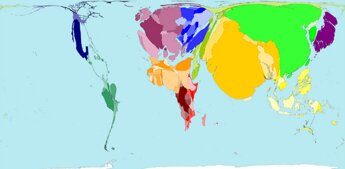The terrorists have won, so says Anna at Sepia Mutiny.
In the wake of the Mumbai terrorist attacks, the Indian government issued a directive to internet service providers to start blocking sites hosted by Google’s Blogger service, TypePad and Geocities. The alleged reason for the block: terrorists have been using the internet to communicate.
We shudder at the thought that India’s intelligence services will eventually discover that terrorists also use telephones, national postal services and pencils.
UltraBrown offers the following comment:
As the world’s back office, for India to blame overzealous techies would hardly be credible. It’s not yet clear which blogs the government was targeting, but banning all of Blogspot is nothing less than outright repression — mimicking the tactics Pakistan used to shut down discussion of Danish cartoons critical of Islam. India is now in the august company of some of the world’s least free nations
Amit Varma, who just penned a piece for the Guardian on how collaborative blogs such as Mumbai Help can be put to use in a crisis ponders: ” Won’t it be ironic if, after all that Mumbai Help attempted to do last week, residents of Mumbai aren’t even able to access it?”
Much, much more at DesiPundit, Global Voices and .
While India is following the route of authoritarian China in blocking blog hosting services, curiously neither country has banned . Although concerns abound about online sexual predators using the service, we must assume the youth-oriented service is free from terrorists, pro-democracy dissidents and Falun Gong practitioners.
Technorati Tags: asia, censorship, india, south asia
 If you are late for work in Mumbai and reach the station just as the train is leaving the platform, don’t despair. You can run up to the packed compartments and find many hands unfolding like petals to pull you on board. And while you will probably have to hang on to the door frame with your fingertips, you are still grateful for the empathy of your fellow passengers, already packed tighter than cattle, their shirts drenched with sweat in the badly ventilated compartment. They know that your boss might yell at you or cut your pay if you miss this train. And at the moment of contact, they do not know if the hand reaching for theirs belongs to a Hindu or a Muslim or a Christian or a Brahmin or an Untouchable. Come on board, they say. We’ll adjust.
If you are late for work in Mumbai and reach the station just as the train is leaving the platform, don’t despair. You can run up to the packed compartments and find many hands unfolding like petals to pull you on board. And while you will probably have to hang on to the door frame with your fingertips, you are still grateful for the empathy of your fellow passengers, already packed tighter than cattle, their shirts drenched with sweat in the badly ventilated compartment. They know that your boss might yell at you or cut your pay if you miss this train. And at the moment of contact, they do not know if the hand reaching for theirs belongs to a Hindu or a Muslim or a Christian or a Brahmin or an Untouchable. Come on board, they say. We’ll adjust.

 A Reader’s Digest survey conducted in 35 various cities across the globe analysed and tested the politeness and helpfulness of people in each urban centre. More than 2000 separate tests of behaviour were conducted to try and find the world’s most courteous place….
A Reader’s Digest survey conducted in 35 various cities across the globe analysed and tested the politeness and helpfulness of people in each urban centre. More than 2000 separate tests of behaviour were conducted to try and find the world’s most courteous place….
 A Kashmiri man was recently injured by an explosive cigarette either distributed by militants or airdropped by
A Kashmiri man was recently injured by an explosive cigarette either distributed by militants or airdropped by  The 77-year-old Rajkumar gave up acting almost a decade ago. Its tough to believe that the youth pelting stones at policemen across the city today watched too many of his films, if any. None of the television images showed them to be grieving. Instead their faces showed the thrill one usually associates with the satisfaction of inflicting damage on the establishment. Many were performing for the cameras,leaping with joy.
The 77-year-old Rajkumar gave up acting almost a decade ago. Its tough to believe that the youth pelting stones at policemen across the city today watched too many of his films, if any. None of the television images showed them to be grieving. Instead their faces showed the thrill one usually associates with the satisfaction of inflicting damage on the establishment. Many were performing for the cameras,leaping with joy.


 Go to the main entry of authority ( A small passage between building and parking.) You can see many agents (or say dalal), you can contact to any cameraman, shopkeeper or roadvendor. I got one (cameraman introduced him with me). I started talking with him, he said sit down don’t talk like this now a days position are strict. We fix up the deal in Rs.490. Then he introduced me to his boss. He asked Rs.600, I said no I was told Rs.490 only. He agreed on that. He took my papers and hand over those to his guy to get the entry in official books, and told me to bring my car for test.
Go to the main entry of authority ( A small passage between building and parking.) You can see many agents (or say dalal), you can contact to any cameraman, shopkeeper or roadvendor. I got one (cameraman introduced him with me). I started talking with him, he said sit down don’t talk like this now a days position are strict. We fix up the deal in Rs.490. Then he introduced me to his boss. He asked Rs.600, I said no I was told Rs.490 only. He agreed on that. He took my papers and hand over those to his guy to get the entry in official books, and told me to bring my car for test.

 Citigroup however thinks the gap should be smaller. Citi predicts that China will grow at 8.7%, while India at 8.1%, which produces a merely 0.6% gap compared to DB’s 2.1%. I have to mention that Citi’s 8.1% forecast of India GDP growth in year 2006 is the highest among all major forecasters. Their forecast of 7.5% for last year was also the highest. Citi does love Indian foods!
Citigroup however thinks the gap should be smaller. Citi predicts that China will grow at 8.7%, while India at 8.1%, which produces a merely 0.6% gap compared to DB’s 2.1%. I have to mention that Citi’s 8.1% forecast of India GDP growth in year 2006 is the highest among all major forecasters. Their forecast of 7.5% for last year was also the highest. Citi does love Indian foods!








































